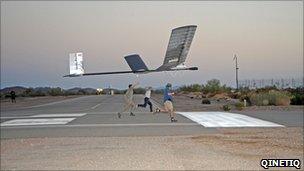'Eternal' solar plane's records are confirmed
- Published

The 50kg Zephyr is launched by hand
The UK-built solar-powered Zephyr aeroplane has been confirmed as a record-breaker following its non-stop two-week flight earlier this year.
The world governing body for air sports records, the Federation Aeronautique Internationale (FAI), gave Zephyr three records including longest time aloft.
Built by defence technology company Qinetiq, the craft completed its two-week flight in the US in July.
The company sees applications in surveillance and communications.
The July feat led to Zephyr being dubbed the "eternal plane".
"This aircraft can help track pirates off the Horn of Africa, alert the authorities about where and how fast forest fires are spreading, and ensure that soldiers' communications remain unaffected when fighting in mountainous or hilly terrain," said Qinetiq's chief designer Chris Kelleher.
The FAI noted that Zephyr smashed the previous record for the absolute duration of an unmanned autonomous vehicle (UAV) flight - set by Northrop Grumman's Global Hawk in 2001 - by a factor of 11.
The organisation set the official duration at 336 hours, 22 minutes and eight seconds.
Zephyr's flight also set a new mark for flight duration for a UAV of its class - unmanned craft weighing 50-500kg - and, for that class, the altitude record of 21,562m (70,741ft).
Wing-to-tail guide to a prototype of the 'eternal' plane
Launched by hand, the aircraft flies during daytime on electricity generated by photovoltaic arrays - solar panels - on its wings.
Made of amorphous silicon, the arrays are about as thick as a sheet of paper. They also charge lithium-sulphur batteries that power the craft by night.
During the flight in July, engineers found that Zephyr lost some altitude during the night as power to the engines reduced - but the batteries stored enough to keep the craft aloft.
Key to its success is the ultra-light design, based on carbon fibre, which means that with a wingspan of 22.5m (74ft) it weighs little more than 50kg (110 lb).
Solar-powered high-altitude long-endurance (Hale) UAVs are expected to have a wide range of applications.
The military will want to use them as reconnaissance and communications platforms. Civilian and scientific programmes will equip them with small payloads for Earth observation duties.
Their unique selling point is their persistence over a location. Low-Earth orbiting satellites come and go in a swift pass overhead, and the bigger drones now operated by the military still need to return to base at regular intervals for refuelling.
- Published23 July 2010
- Published23 July 2010